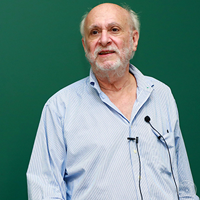
Asst. Prof. Mona Azadkia
ETH Zurich, Switzerland
Title: A Simple Measure of Conditional Dependence
Abstract: We propose a coefficient of conditional dependence between
two random variables, Y and Z, given random vector X based on an i.i.d. sample. The
coefficient has a long list of desirable properties, the most important of which is that
under absolutely no distributional assumptions, it converges to a limit in [0,1], where
the limit is 0 if and only if Y and Z are conditionally independent, given X and is one
if and only if Y is equal to a measurable function of Z given X. Using this statistic,
we devise a new variable selection algorithm, called Feature Ordering by Conditional
Independence (FOCI), which is model-free, has no tuning parameters, and is provably
consistent under sparsity assumptions. We introduce some recent advances based on this
measure.

Asst. Prof. Matteo Bonvini
Rutgers University, USA
Title: On the possibility of doubly robust root-n
inference.
Abstract: We study the problem of constructing an estimator of the
average treatment effect (ATE) that exhibits doubly-robust asymptotic linearity (DR-AL).
This is a stronger requirement than doubly-robust consistency. In fact, a DR-AL
estimator can yield asymptotically valid Wald-type confidence intervals even in the case
when the propensity score or the outcome model is inconsistently estimated. On the
contrary, the celebrated doubly-robust, augmented-IPW estimator requires consistent
estimation of both nuisance functions for root-n inference. Previous authors have
considered this problem (van der Laan, 2014, Benkeser et al, 2017, Dukes et al 2021) and
provided sufficient conditions under which the proposed estimators are DR-AL. Such
conditions are typically stated in terms of ``high-level nuisance error rates" needed
for root-n inference. In this paper, we build upon their work and establish sufficient
and more explicit smoothness conditions under which a DR-AL estimator can be
constructed. We also consider the case of slower-than-root-n convergence rates and study
minimax optimality within the structure-agnostic framework proposed by Balakrishnan et
al (2023). Finally, we clarify the connection between DR-AL estimators and those based
on higher-order influence functions (Robins et al, 2017) and complement our theoretical
findings with simulations.

Dr. Guangyi Chen
MBZUAI, UAE
Title: We will announce soon
Abstract: We will announce soon.

Asst. Prof. Carlos Cinelli
UW-Seattle, USA
Title: Long Story Short: Omitted Variable Bias in Causal
Machine Learning
Abstract: We derive general, yet simple, sharp bounds on the size of
the omitted variable bias for a broad class of causal parameters that can be identified
as linear functionals of the conditional expectation function of the outcome. Such
functionals encompass many of the traditional targets of investigation in causal
inference studies, such as, for example, (weighted) average of potential outcomes,
average treatment effects (including subgroup effects, such as the effect on the
treated), (weighted) average derivatives, and policy effects from shifts in covariate
distribution--all for general, nonparametric causal models. Our construction relies on
the Riesz-Frechet representation of the target functional. Specifically, we show how the
bound on the bias depends only on the additional variation that the latent variables
create both in the outcome and in the Riesz representer for the parameter of interest.
Moreover, in many important cases (e.g, average treatment effects and avearage
derivatives) the bound is shown to depend on easily interpretable quantities that
measure the explanatory power of the omitted variables. Therefore, simple plausibility
judgments on the maximum explanatory power of omitted variables (in explaining treatment
and outcome variation) are sufficient to place overall bounds on the size of the bias.
Furthermore, we use debiased machine learning to provide flexible and efficient
statistical inference on learnable components of the bounds. Finally, empirical examples
demonstrate the usefulness of the approach.

Asst. Prof. Yifan Cui
Zhejiang University, China
Title: Policy Learning with Distributional Welfare
Abstract: In this paper, we explore optimal treatment allocation
policies that target distributional welfare. Most literature on treatment choice has
considered utilitarian welfare based on the conditional average treatment effect (ATE).
While average welfare is intuitive, it may yield undesirable allocations especially when
individuals are heterogeneous (e.g., with outliers) - the very reason individualized
treatments were introduced in the first place. This observation motivates us to propose
an optimal policy that allocates the treatment based on the conditional quantile of
individual treatment effects (QoTE). Depending on the choice of the quantile
probability, this criterion can accommodate a policymaker who is either prudent or
negligent. The challenge of identifying the QoTE lies in its requirement for knowledge
of the joint distribution of the counterfactual outcomes, which is generally hard to
recover even with experimental data. Therefore, we introduce minimax policies that are
robust to model uncertainty. A range of identifying assumptions can be used to yield
more informative policies. For both stochastic and deterministic policies, we establish
the asymptotic bound on the regret of implementing the proposed policies. In simulations
and two empirical applications, we compare optimal decisions based on the QoTE with
decisions based on other criteria. The framework can be generalized to any setting where
welfare is defined as a functional of the joint distribution of the potential outcomes.

Asst. Prof. Xiaowu Dai
University of California, Los Angeles, USA
Title: Kernel ordinary differential equations
Abstract: The ordinary differential equation (ODE) is widely used in
modelling biological and physical processes in science. A new reproducing kernelbased
approach is proposed for the estimation and inference of ODE given noisy observations.
The functional forms in ODE are assumed to be known or restricted to be linear or
additive, and pairwise interactions are allowed. Sparse estimation is performed to
select individual functionals and construct confidence intervals for the estimated
signal trajectories. The estimation optimality and selection consistency of kernel ODE
are established under both the low-dimensional and high-dimensional settings, where the
number of unknown functionals can be smaller or larger than the sample size. The
proposal builds upon the smoothing spline analysis of variance (SS-ANOVA) framework, but
tackles several important problems that are not yet fully addressed, and extends the
existing methods of dynamic causal modeling.

Dr. Yuhao Deng
University of Michigan, USA
Title: Causal Inference in Multi-state Models with
Multiple Intermediate Events
Abstract: Multi-state models are widely used in biomedical sciences to
demonstrate the disease progression mechanism. However, causal inference in multi-state
models is challenging due to the complicated interaction between treatment and history
in transition rates. We adopt the counterfactual cumulative incidence of an event as the
estimand. Then treatment effects are defined by contrasting counterfactual cumulative
incidences under different combinations of transition-specific treatment components.
Under a dismissible treatment components condition, we derive the semiparametric
efficient estimators for the counterfactual cumulative incidences and treatment effects.
Then we provide hypothesis testing methods to test the treatment effects. The proposed
framework has three potential uses: (1) to detect on which event the treatment has an
effect on, (2) to estimate path-specific treatment effects, and (3) to infer optimal
dynamic treatment regimes. Through a real-world application on stem cell
transplantation, we illustrate the usefulness of the proposed framework.

Assoc. Prof. Ivan Diaz
New York University, USA

Asst. Prof. Kara E. Rudolph
University of Columbia, USA
Title: Improving Efficiency in Transporting Average
Treatment Effects
Abstract: We develop flexible, semiparametric estimators of the
average treatment effect (ATE) transported to a new population (``target population'')
that offer potential efficiency gains. First, we propose two one-step semiparametric
estimators that incorporate knowledge of which covariates are effect modifiers and which
are both effect modifiers and differentially distributed between the source and target
populations. These estimators can be used even when not all covariates are observed in
the target population; one requires that only effect modifiers are observed, and the
other requires that only those modifiers that are also differentially distributed are
observed. Second, we propose a collaborative one-step estimator when researchers do not
have knowledge about which covariates are effect modifiers and which differ in
distribution between the populations, but require all covariates to be measured in the
target population. We use simulation to compare finite sample performance across our
proposed estimators and existing estimators of the transported ATE, including in the
presence of practical violations of the positivity assumption. Lastly, we apply our
proposed estimators to a large-scale housing trial.

Dr. Konstantin Genin
University of Tübingen, Germany
Title:We will announce soon.
Abstract: We will announce soon.

Assoc. Prof. Zijian Guo
Rutgers University, USA
Title: We will announce soon
Abstract: We will announce soon.

Ms. Yiyi Huo
UW-Seattle, USA
Title:On the adaptation of causal forests to manifold data
Abstract: Researchers often hold the belief that random forests are
"the cure to the world's ills". But how exactly do they achieve this? Focused on the
recently introduced causal forests, we aim to contribute to an ongoing research trend
towards answering this question, proving that causal forests can adapt to the unknown
covariate manifold structure. In particular, our analysis shows that a causal forest
estimator can achieve the optimal rate of convergence for estimating the conditional
average treatment effect, with the covariate dimension automatically replaced by the
manifold dimension.

Prof. Zhichao Jiang
Sun Yat-sen University, China
Title: Principal Stratification with Continuous Post-Treatment
Variables
Abstract: Post-treatment variables often complicate causal inference.
They appear in many scientific problems, including noncompliance, truncation by death,
mediation, and surrogate endpoint evaluation. Principal stratification is a strategy
that adjusts for the potential values of the post-treatment variables, defined as the
principal strata. It allows for characterizing treatment effect heterogeneity across
principal strata and unveiling the mechanism of the treatment on the outcome related to
post-treatment variables. However, the existing literature has primarily focused on
binary post-treatment variables, leaving the case with continuous post-treatment
variables largely unexplored, due to the complexity of infinitely many principal strata
that challenge both the identification and estimation of causal effects. We fill this
gap by providing nonparametric identification and semiparametric estimation theory for
principal stratification with continuous post-treatment variables. We propose to use
working models to approximate the underlying causal effect surfaces and derive the
efficient influence functions of the corresponding model parameters.

Prof. Theis Lange
University of Copenhagen, Denmark
Title: We will announce soon
Abstract: We will announce soon

Prof. Mark Van Der Lann
University of California, Berkeley, USA
Title: Targeted Learning, HAL, and Causal Inference for Generating
Real World Evidence in Drug Development
Abstract: Targeted Learning follows a general roadmap for 1) accurately
translating the real world into a formal statistical estimation problem in terms of
causal estimand, a corresponding statistical estimand, and statistical model; 2) a
corresponding template for construction of a targeted maximum likelihood estimator
(TMLE) of the statistical estimand; and finally 3) a sensitivity analysis addressing the
possible causal gap. The TMLE represents an optimal plug-in machine learning based
estimator of the estimand combined with formal statistical inference. The three pillars
of TMLE are super-learning, Highly Adaptive Lasso (HAL), and the TMLE-update step, where
the latter has various choices such as CV-TMLE/C-TMLE, and the recently developed
adaptive TMLE (Lars van der Laan et al., 2023). Through super-learning it can
incorporate high dimensional and diverse data sources such as images, NLP features, and
state of art algorithms tailored for such data sources. To optimize finite sample
performance, the precise specification of TMLE can be tailored towards the precise
experiment and statistical estimation problem in question, while being theoretically
grounded, optimal, and benchmarked. We provide a motivation, explanation, and overview
of targeted learning; the key role of super-learning and HAL; discuss some of the key
choices and considerations in specifying the TMLE-step; and discuss (a priori specified)
SAP construction based on targeted learning, incorporating outcome-blind simulations to
choose a best specification of the SAP. We also discuss a Sentinel and FDA RWE
demonstration project of targeted learning demonstrating SAP specification on real data.

Assoc. Prof. Wei Li
Renming University of China, China
Title: Inference of Possibly Bi-directional Causal Relationships with
Invalid Instrumental Variables
Abstract: Learning causal relationships between pairs of complex traits
from observational studies is of great interest across various scientific domains.
However, most existing methods assume the absence of unmeasured confounding and restrict
relationships between two traits to be uni-directional, which may be violated in
real-world systems. In this paper, we address the challenge of causal discovery and
effect estimation for two traits while accounting for unmeasured confounding and
potential feedback loops. By leveraging possibly invalid instrumental variables, we
establish sufficient identifying conditions for bi-directional and uni-directional
models, respectively. Then we introduce a data-driven procedure to detect whether the
causal relationship is bi-directional. When it is detected to be uni-directional, we
propose another procedure to determine the causal direction. We show that our method can
consistently identify the true direction between two traits. Additionally, we provide
estimation and inference results about causal effects along the identified direction.
The proposed estimators are asymptotically normal under certain regularity conditions.
We demonstrate the proposed method via simulations and real data examples from UK
Biobank.

Asst. Prof. Xinran Li
University of Chicago, USA
Title: Robust Sensitivity Analysis for Matched Observational
Studies
Abstract: Observational studies provide invaluable opportunities for
causal inference, but they often suffer from biases due to pretreatment difference
between treated and control units. Matching has been a popular approach to reduce
observed covariate imbalance. To tackle the unmeasured confounding, Rosenbaum proposed a
sensitivity analysis framework for matched observational studies, which adapts and
extends the conventional randomization inference for randomized experiments. However,
Rosenbaum’s analysis may exhibit two potential limitations. First, it focuses mainly on
sharp null hypotheses, say Fisher’s null of no effect for any unit, which can be
restrictive in practice and are not able to accommodate unknown individual effect
heterogeneity. Second, it considers mainly a uniform bound on the strength of hidden
confounding across matched sets, under which the sensitivity analysis will lose power if
extreme hidden confounding is suspected, e.g., some units may be almost certain to take
the treatment or control due to unmeasured confounding. In this talk, we will extend
Rosenbaum’s framework to overcome both limitations. First, we propose sensitivity
analysis for quantiles of individual treatment effects, without any constant-effects
assumptions. Second, we will propose sensitivity analysis based on quantiles of hidden
biases, which can strengthen the evidence supporting a causal finding.

Asst. Prof. Zhaotong Lin
Florida State University, USA
Title: A Robust Cis-Mendelian Randomization Method with Application to
Drug Target Discovery
Abstract: Mendelian randomization (MR) uses genetic variants as
instrumental variables (IVs) to investigate a causal relationship between two traits, an
exposure and an outcome. Compared to conventional MR using only independent IVs selected
from the whole genome, cis-MR focuses on a single genomic region using only cis-SNPs.
For example, using cis-pQTLs for each circulating protein as an exposure for a disease
opens an economical path for drug target discovery. Despite the significance of such
applications, only few methods are robust to (horizontal) pleiotropy and linkage
disequilibrium (LD) of cis-SNPs as IVs. In this work, we propose a cis-MR method based
on constrained maximum likelihood, called cisMR-cML, which accounts for LD and
(horizontal) pleiotropy in a general likelihood framework. It is robust to the violation
of any of the three valid IV assumptions with strong theoretical support. We further
clarify the severe but largely neglected consequence of the current practice of modeling
marginal effects, instead of conditional effects, of SNPs in cis-MR analysis. Numerical
studies demonstrated the advantage of our method over other existing methods. We applied
our method in a drug-target analysis for coronary artery disease (CAD), including a
proteome-wide application, in which three potential drug targets, PCSK9, COLEC11 and
FGFR1, for CAD were identified.

Asst. Prof. Lin Liu
Shanghai Jiaotong University, China
Title: DNA-SE: Towards Deep Neural-Nets Assisted Semiparametric
Estimation
Abstract: Semiparametric statistics play a pivotal role in a wide range
of domains, including but not limited to missing data, causal inference, and transfer
learning, to name a few. In many settings, semiparametric theory leads to (nearly)
statistically optimal procedures that yet involve numerically solving Fredholm integral
equations of the second kind. Traditional numerical methods, such as polynomial
approximations or grid-based methods, are difficult to scale to multi-dimensional
problems. Alternatively, statisticians may choose to approximate the original integral
equations by ones with closed-form solutions, resulting in computationally more
efficient, but statistically suboptimal or even incorrect procedures. To bridge this
gap, we propose a new framework by formulating the semiparametric estimation problem as
a bi-level optimization problem; and then we develop a scalable algorithm called Deep
Neural-Nets Assisted Semiparametric Estimation (DNA-SE) by leveraging the universal
approximation property of Deep Neural-Nets (DNN) to streamline semiparametric
procedures. Through extensive numerical experiments and a real data analysis, we
demonstrate the numerical and statistical advantages of (DNA-SE) over traditional
methods.

Assoc. Prof. Ruixuan Liu
The Chinese University of Hong Kong, China
Title: Double Robust Bayesian Inference on Average Treatment
Effects
Abstract: We propose a double robust Bayesian inference procedure on
the average treatment effect (ATE) under unconfoundedness. Our robust Bayesian approach
involves two important modifications: first, we adjust the prior distributions of the
conditional mean function; second, we correct the posterior distribution of the
resulting ATE. Both steps make use of a pilot estimator of the Riesz representor. We
prove asymptotic equivalence of our Bayesian estimator and double robust frequentist
estimators by establishing a new semiparametric Bernstein-von Mises theorem under double
robustness; i.e., the lack of smoothness of conditional mean functions can be
compensated by high regularity of the propensity score and vice versa. Consequently, the
resulting Bayesian point estimator internalizes the bias correction and the Bayesian
credible sets form confidence intervals with asymptotically exact coverage probability.
In simulations, our robust Bayesian procedure leads to significant bias reduction of
point estimation and accurate coverage of confidence intervals, especially when the
dimensionality of covariates is large relative to the sample size and the underlying
functions become complex. We illustrate our method in an application to the National
Supported Work Demonstration.

Asst. Prof. Zhonghua Liu
Columbia University, USA
Title: Robust Mendelian Randomization Coupled with Alphafold2 for Drug
Target Discovery
Abstract: Mendelian randomization (MR) uses genetic variants as
instrumental variables (IVs) to infer the causal effect of a modifiable exposure on the
outcome of interest by removing unmeasured confounding bias. However, some genetic
variants might be invalid IVs due to violations of core IV assumptions. MR analysis with
invalid IVs might lead to biased causal effect estimate and misleading scientific
conclusions. To address this challenge, we propose a novel MR method that first Selects
valid genetic IVs and then performs Post-selection Inference (MR-SPI) based on
two-sample genome-wide summary statistics. We analyze 912 plasma proteins using the
large-scale UK Biobank proteomics data in 54,306 participants and identify 7 proteins
significantly associated with the risk of Alzheimer’s disease. We employ AlphaFold2 to
predict the 3D structural alterations of these 7 proteins due to missense genetic
variations, providing new insights into their biological functions in disease etiology.

Asst. Prof. Francesco Locatello
Institute of Science and Technology Austria
Title: We will annonuce soon
Abstract: We will annonuce soon.

Prof. Wenbin Lu
North Carolina State University, USA
Title: Off-Policy Evaluation with Irregularly-Spaced,
Outcome-Dependent Observation Times
Abstract: While the classic off-policy evaluation (OPE) literature
commonly assumes decision time points to be evenly spaced for simplicity, in many
real-world scenarios, such as those involving user-initiated visits, decisions are made
at irregularly-spaced and potentially outcome-dependent time points. For a more
principled policy evaluation, this paper introduces a novel OPE framework which concerns
not only the (state-action) decision-making process but also an observation process that
dictates the time points at which decisions are made. Two distinct value functions,
derived from cumulative rewards and integrated rewards respectively, are formulated
within the framework. Statistical inference for each value function is developed under
modified Markov and time-homogeneous assumptions. The validity of our method is further
supported by theoretical results, simulation studies, and a real-world application in
dental treatment.

Assoc. Prof. Kosuke Morikawa
Osaka University, Japan
Title: Singular Propensity Score: Reducing Variance in Weighted
Estimators
Abstract: In the fields of survey sampling, missing data analysis, and
causal inference, researchers often have access to only a subset of the population of
interest, which can lead to biased results. To correct this bias, weighting the
estimating equations with the inverse of the propensity scores is a common method.
However, this approach encounters challenges when propensity scores are extremely close
to 0 or 1, as the inverse probabilities may cause divergence, thereby increasing the
variance of the estimates. To address this issue, this talk introduces a singular
propensity score that incorporates upper and lower bounds. We propose an information
criterion specifically designed for selecting these bounds, based on observed data, and
propose a new weighted estimator that aims to minimize mean squared error.

Asst. Prof. Daniel Malinsky
Columbia University, USA
Title: Post-selection inference for causal effects after causal
discovery Assoc. Prof. Yumou Qiu
Title: We will announce soon Assoc. Prof. Bruno Ribeiro
Title: Leveraging Causal
Invariances for Improved Zero-Shot Domain Generalization in Neural Networks
Prof. Donald B. Rubin
Title: Is there a role for
counternull sets in statistical
practice? Prof. Shohei Shimizu
Title: Causal Discovery Based on
Non-Gaussianity and
Nonlinearity Dr. Xinwei Shen
Title: Distributional Instrumental
Variable Regression Prof. Dylan Small
Title: Exploratory Data Analysis,
Confirmatory Data Analysis
and Replication in the Same Observational Study: A Two Team Cross-Screening
Approach to Studying the Effect of Unwanted Pregnancy on Mothers' Later Life
Outcomes
Abstract: Algorithms for constraint-based causal discovery select
graphical causal models from among a space of possible candidates (e.g., all directed
acyclic graphs) by executing a sequence of conditional independence tests. These may be
used to inform the estimation of causal effects (e.g., average treatment effects) when
there is uncertainty about which covariates ought to be adjusted for, or which variables
act as confounders versus mediators. However, naively using the data twice, for model
selection and estimation, would lead to invalid confidence intervals. Moreover, if the
selected graph is incorrect, the inferential claims may apply to a chosen functional
that is distinct from the actual causal effect. We propose an approach to post-selection
inference that is based on a resampling procedure, that essentially performs causal
discovery multiple times with randomly varying intermediate test statistics. Then, an
estimate of the target causal effect and corresponding confidence sets are constructed
from a union of individual graph-based estimates and intervals. We show that this
construction has asymptotically correct coverage. Though most of our exposition focuses
on the PC algorithm for learning directed acyclic graphs and the multivariate Gaussian
case for simplicity, the approach is general and modular, so it can be used with other
conditional independence based discovery algorithms and (semi-)parametric families. This
is joint work with Ting-Hsuan Chang and Zijian Guo.

Peking University, China
Abstract: We will announce soon.

Purdue University, USA
Abstract: In this
talk, we explore how the imposition of different types of causal invariances
within neural networks forces them to learn domain-transferable, invariant
patterns that significantly bolster zero-shot domain and out-of-distribution
(OOD) generalizations. We will start discussing how invariances improve abstract
reasoning capabilities of neural networks for zero-shot domain generalization in
knowledge graphs. Then, we extend the exploration of this causal
invariance-centric design principle to a diverse array of OOD generalization
scenarios, ranging from causal link prediction and computer networking to
emerging frontiers in Physics-Informed Machine Learning. This talk aims to
discuss the transformative potential of causality and invariance in improving
robustness and domain transferability in neural networks.

Tsinghua University, China
Abstract: We will announce soon.

Shiga University and RIKEN, Japan
Abstract: Statistical causal
inference is a methodology that
combines domain knowledge and data to support decision-making based on
understanding causal mechanisms. A central problem in science is to elucidate
the causal mechanisms underlying natural phenomena and human behavior.
Statistical causal inference offers various tools to study such mechanisms.
However, due to a lack of background knowledge, preparing causal graphs required
for performing statistical causal inference is often difficult. To alleviate
this difficulty, a lot of work has been conducted to develop statistical methods
for estimating causal relationships, i.e., the causal structure of variables,
from observational data obtained from sources other than randomized experiments.
Statistical causal discovery is such a methodology that uses data to infer the
causal structure of variables. This talk outlines the basic ideas of statistical
causal discovery to introduce some recent advances in the field. In particular,
I will focus on methods based on non-Gaussianity and non-linearity that can
handle unobserved variables.

ETH Zurich, Switzerland
Abstract: We will announce soon.

University of Pennsylvania, USA
Abstract: Exploratory data analysis,
confirmatory data analysis
and replication are three important aspects of building strong evidence from
observational studies. Exploratory data analysis, confirmatory data analysis
and replication are often thought of as being done on separate studies.
However, for settings where randomized experiments are impossible to conduct for
ethical reasons and observational studies must be relied on, it is common that
there is a data set with unique strengths. We develop a two-team cross
screening approach that allows for exploratory data analysis, confirmatory data
analysis and replication to be done in the same observational study data set.
We apply the approach to study the effect of unwanted pregnancy on mothers’
later life outcomes using data from the Wisconsin Longitudinal Study. This is
joint work with Samrat Roy, Marina Bogomolov, Ruth Heller, Amy Claridge and
Tishra Beeson.

Assoc. Prof. Maarten van Smeden
UMC Utrecht, Netherlands
Title: Clinical Prediction Modeling in the Era of AI: A Blessing and a Curse
Abstract: Medicine has a long history of using clinical prediction models to guide medical decision making and inform patients about prognosis and diagnosis. In the current era of AI, accessible high-performance computing, and large datasets, the possibilities for developing better clinical prediction models seem endless. The reality, however, is different. In this talk, I will reflect some of the blessings and some of the curses that come with the new era of AI in clinical prediction modeling.

Dr. Matthew Smith
London School of Hygiene and Tropical Medicine, UK
Title: A New Weighted Estimator for Causal
Inference in the Relative
Survival Setting
Abstract: In public health research, the causal
effect of a treatment (or
exposure/intervention/policy) on cause-specific death after a disease diagnosis is often of
interest. Other causes of death prevent the event of interest from happening, thus defining
a competing risk setting. In such settings, the total (or direct) causal effect can be
estimated when the cause of death is known because the overall hazard of death can be
decomposed into the sum of cause-specific hazards (due to the disease and due to
other-cause) (Young et al , 2020). However, this relies on a strong assumption of knowing
the exact cause of death, which, if violated, could lead to biased estimates of the causal
effect: in population-based settings, records for the cause of death are often unreliable or
poorly recorded.
Alternatively, one could estimate the causal effect of the treatment in a relative survival
setting by using external information obtained from population life tables (stratified by
sociodemographic characteristics) to estimate the other-cause mortality hazard and then
estimate the disease-specific mortality hazard (Pohar Perme et al , 2016). The relationship
between these hazards can be arranged to give a probability that an observed death is due to
the cause of interest or other causes (Maringe et al , 2018). In a population-based cohort
of patients with a disease of interest, we propose to weight the overall mortality (i.e.,
regardless the cause of death) by the probability of cause-type. After applying weights, the
total causal effect is estimated using the g-formula in a conventional competing risk
analysis, thereby providing marginal causal interpretations for the estimand of interest
(Young et al , 2020).
We will illustrate the performance of our proposed methodological framework using a
simulation study and highlight its benefits and interpretation in a practical application
using population-based cancer data.

Dr. Bingkai Wang
University of Pennsylvania, USA
Title: Model-Robust and Efficient Covariate Adjustment
for Cluster-Randomized
Experiments
Abstract: Cluster-randomized experiments are
increasingly used to evaluate
interventions in routine practice conditions, and researchers often adopt model-based methods
with covariate adjustment in the statistical analyses. However, the validity of model-based
covariate adjustment remains unclear when the working models are misspecified, leading to
ambiguity of estimands and risk of bias. In this article, we first adapt two model-based
methods—generalized estimating equations and linear mixed models—with weighted g-computation to
achieve robust inference for cluster-average and individual-average treatment effects. To
further overcome the limitations of model-based covariate adjustment methods, we propose
efficient estimators for each estimand that allow for flexible covariate adjustment and
additionally address cluster size variation dependent on treatment assignment and other cluster
characteristics. Such cluster size variations often occur post-randomization and, if ignored,
can lead to bias of model-based estimators. For our proposed covariate-adjusted estimators, we
prove that when the nuisance functions are consistently estimated by machine learning
algorithms, the estimators are consistent, asymptotically normal, and efficient. When the
nuisance functions are estimated via parametric working models, the estimators are
triply-robust. Simulation studies and analyses of three real-world cluster-randomized
experiments demonstrate that the proposed methods are superior to existing alternatives.

Prof. Lan Wang
University of Miami, USA
Title: We will announce soon.
Abstract: We will announce soon.

Asst. Prof. Yixin Wang
University of Michigan, USA
Title: Harnessing Geometric Signatures in Causal
Representation Learning
Abstract: Causal representation learning aims to extract
high-level latent causal
factors from low-level sensory data. Many existing methods often identify these latent factors by
assuming they are statistically independent. However, correlations and causal connections between
factors are prevalent across applications. In this talk, we explore how geometric signatures of
latent causal factors can facilitate causal representation learning with interventional data,
without any assumptions about their distributions or dependency structure. The key observation is
that the absence of causal connections between latent causal factors often carries geometric
signatures of the latent factors' support (i.e. what values each latent can possibly take).
Leveraging this fact, we can identify latent causal factors up to permutation and scaling with data
from perfect do interventions. Moreover, we can achieve block affine identification with data from
imperfect interventions. These results highlight the unique power of geometric signatures in causal
representation learning.

Asst. Prof. Haoran Xue
City University of Hong Kong, China
Title: Inferring causal direction between two traits
using
R-squared with application to transcriptome-wide association studies
Abstract: In the framework of Mendelian randomization,
two
single SNP-trait Pearson’s correlation-based methods have been developed to infer the causal
direction
between an exposure (e.g. a gene) and an outcome (e.g. a trait), including the widely used MR
Steiger’s
method and its recent extension called Causal Direction-Ratio (CD-Ratio). Steiger’s method uses a
single
SNP as an instrumental variable (IV) for inference, while CD-Ratio combines the results from each of
multiple SNPs. Here we propose an approach based on R-squared, the coefficient of determination, to
simultaneously combine information from multiple (possibly correlated) SNPs to infer the presence
and
direction of a causal relationship between an exposure and an outcome. Our proposed method can be
regarded as a generalization of Steiger’s method from using a single SNP to multiple SNPs as IVs. It
is
especially useful in transcriptome-wide association studies (TWAS) (or similar applications) with
typically small sample sizes for gene expression (or other molecular trait) data, providing a more
flexible and powerful approach to inferring causal directions. It can be applied to GWAS summary
data
with a reference panel. We also discuss its potential robustness to invalid IVs. We compared the
performance of TWAS, Steiger’s method, CD-Ratio, and the new R-squared based method in simulations
to
demonstrate some advantages of the proposed method. We applied the methods to identify causal genes
for
high/low-density lipoprotein cholesterol (HDL/LDL) using the individual-level GTEx (V8) gene
expression
data and UK Biobank GWAS data. The proposed method was able to confirm some well-known causal genes,
and
identified some novel gene-trait relationships, suggesting its power gains through its use of
multiple
correlated SNPs as IVs.

Prof. Fan Yang
Tsinghua University, China
Title: An Integrative Multi-context Mendelian
Randomization
Method for Identifying
Risk Genes Across Human Tissues
Abstract: Mendelian randomization (MR) provides valuable
assessments of the causal
effect of exposure on outcome, yet the application of conventional MR methods for mapping risk genes
encounters new challenges. One of the issues is the limited availability of expression quantitative
trait loci (eQTLs) as instrumental variables (IVs), hampering the estimation of sparse causal
effects. Additionally, the often context/tissue-specific eQTL effects challenge the MR assumption of
consistent IV effects across eQTL and GWAS data. To address these challenges, we propose a
multi-context multivariable integrative MR framework, mintMR, for mapping expression and molecular
traits as joint exposures. It models the effects of molecular exposures across multiple tissues in
each gene region, while simultaneously estimating across multiple gene regions. It uses eQTLs with
consistent effects across more than one tissue type as IVs, improving IV consistency. A major
innovation of mintMR involves employing multi-view learning methods to collectively model latent
indicators of disease relevance across multiple tissues, molecular traits, and gene regions. The
multi-view learning captures the major patterns of disease-relevance and uses these patterns to
update the estimated tissue relevance probabilities. The proposed mintMR iterates between performing
a multi-tissue MR for each gene region and joint learning the disease-relevant tissue probabilities
across gene regions, improving the estimation of sparse effects across genes. We apply mintMR to
evaluate the causal effects of gene expression and DNA methylation for 35 complex traits using
multi-tissue QTLs as IVs. The proposed mintMR controls genome-wide inflation and offers new insights
into disease mechanisms.

Ms. Mengyue Yang
University College London, UK
Title: Essential Causal Representation Learning via Probability of Sufficient and Necessary
Abstract: Causal representation learning aims to discover the implicit causal structures and feature information from observational data, which is generally considered to have stronger robustness and generalization ability compared to the correlational information extracted in traditional machine learning. However, sometimes even stable/invariant causal information may mislead the model to produce incorrect results in certain scenarios, due to the neglect of the sufficiency and necessity of causal variables in leading to predictive outcomes. This talk primarily introduces the method of causal representation learning based on the probability of sufficiency and necessity, and how to apply it in invariant learning tasks.

Assoc. Prof. Shu Yang
North Carolina State University, USA
Title: Multiply robust off-policy evaluation and
learning
under truncation by death
Abstract:Typical off-policy evaluation (OPE) and
off-policy
learning (OPL) are not well-defined problems under "truncation by death", where the outcome of
interest
is not defined after some events, such as death. The standard OPE no longer yields consistent
estimators, and the standard OPL results in suboptimal policies. In this paper, we formulate OPE and
OPL
using principal stratification under "truncation by death". We propose a survivor value function for
a
subpopulation whose outcomes are always defined regardless of treatment conditions. We establish a
novel
identification strategy under principal ignorability, and derive the semiparametric efficiency bound
of
an OPE estimator. Then, we propose multiply robust estimators for OPE and OPL. We show that the
proposed
estimators are consistent and asymptotically normal even with flexible semi/nonparametric models for
nuisance functions approximation. Moreover, under mild rate conditions of nuisance functions
approximation, the estimators achieve the semiparametric efficiency bound. Finally, we conduct
experiments to demonstrate the empirical performance of the proposed estimators.

Asst. Prof. Ruoqi Yu
University of Illinois Urbana-Champaign, USA
Title: Balancing Weights for Causal Inference in
Observational Factorial
Studies
Abstract: Many scientific questions in biomedical,
environmental, and
psychological research involve understanding the effect of multiple factors on outcomes. While
randomized factorial experiments are ideal for this purpose, randomization is often infeasible
in many empirical studies. Therefore, investigators must rely on observational data, where
drawing reliable causal inferences for multiple factors remains challenging. As the number of
treatment combinations grows exponentially with the number of factors, some treatment
combinations can be rare or missing by chance in observed data, further complicating factorial
effects estimation. To address these challenges, we propose a novel weighting method tailored to
observational studies with multiple factors. Our approach uses weighted observational data to
emulate a randomized factorial experiment, enabling simultaneous estimation of the effects of
multiple factors and their interactions. Our investigations reveal a crucial nuance: achieving
balance among covariates, as in single-factor scenarios, is necessary but insufficient for
unbiasedly estimating factorial effects. Our findings suggest that balancing the factors is also
essential in multi-factor settings. Moreover, we extend our weighting method to handle missing
treatment combinations in observed data. Finally, we study the asymptotic behavior of the new
weighting estimators and propose a consistent variance estimator, providing reliable inferences
on factorial effects in observational studies.

Asst. Prof. Bo Zhang
Fred Hutchinson Cancer Center, USA
Title: Nested Instrumental Variables Design:
Switcher
Average Treatment Effect, Identification, Efficient Estimation and Generalizability
Abstract: In this talk, I will introduce how to
leverage
a naturally strengthened, binary IV to assess the generalizability of IV-based estimates. Under
a
monotonicity assumption, a valid binary IV nonparametrically identifies complier average
treatment
effect, whose generalizability is often under debate. In many studies, there may exist multiple
versions of a binary IV, for instance, different nudges to take the treatment in different study
sites in a clinical trial. I will introduce a novel nested IV assumption and study the
identification of the average treatment effect among two latent subgroups: always-compliers and
switchers, who are defined based on the joint potential treatment uptake under two versions of a
binary IV. We derive the efficient influence function for the SWitcher Average Treatment Effect
(SWATE) and propose efficient estimators. We then propose formal statistical tests of the
principal
ignorability assumption based on comparing the conditional average treatment effect among the
always-compliers and that among the switchers under the nested IV framework. This is joint work
with
Rui Wang (UW PhD student), Oliver Dukes (Ghent University) and Yingqi Zhao (Fred Hutch).

Assoc. Prof. Kun Zhang
Carnegie Mellon University, USA & MBZUAI
Title: Advances in Causal Representation Learning:
Discovery of the Hidden World
Abstract: We will announce soon.

Assoc. Prof. Zheng Zhang
Renmin University of China, China
Title: Causal Inference on Quantile Dose-response Functions via Local ReLU Least Squares Weighting
Abstract: This paper proposes a new local ReLU network least squares weighting method to estimate quantile dose-response functions in observational studies. Unlike the conventional inverse propensity weighting (IPW) method, we estimate the weighting function involved in the treatment effect estimator directly through local ReLU least squares optimization. The proposed method takes advantage of ReLU networks applied for the multivariate baseline covariates to alleviate the dimensionality problem while retaining flexibility and local kernel smoothing for the continuous treatment to precisely estimate the quantile dose-response function and prepare for statistical inference. Our method enjoys computational convenience and scalability. It also improves robustness and numerical stability compared to the conventional IPW method. For the ReLU network approximation, we introduce a mixed fractional Sobolev class and show that the two-layer ReLU networks can break the `curse of dimensionality' when the weighting function belongs to this function class. We also establish the convergence rate for the ReLU network estimator and the asymptotic normality of the proposed estimator for the quantile dose-response function. We further propose a multiplier bootstrap method to construct confidence bands for quantile dose-response functions. The finite sample performance of our proposed method is illustrated through simulations and a real data application.

Prof. Xiao-Hua Zhou
Peking University, China
Title: We will announce soon.
Abstract: We will announce soon.